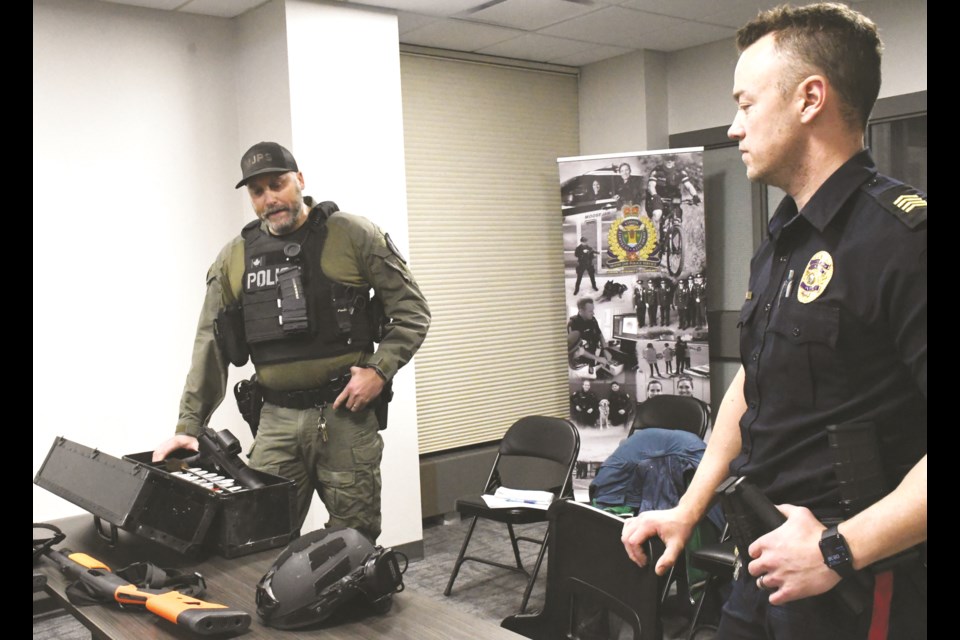MOOSE JAW — The Moose Jaw Police Service’s tactical response team (TRT) typically responds to about four situations annually, but those incidents are usually “highly volatile and potentially dangerous,” the agency says.
TRT members use various tools to handle situations, such as ballistics shields, bean bag-loaded shotguns, 40-millimetre chemical grenade launchers, semi-automatic carbine rifles and body armour.
All these fancy — and potentially lethal — tools were on display during the Board of Police Commissioners’ January meeting as TRT members Chad Scheske and Taylor Elder discussed the unit’s abilities.
Staff Sgt. Scheske has been with the unit since 2021, while Staff Sgt. Elder was one of the first two officers selected in 2019 to help build the unit.
Small but mighty
The TRT is comprised of eight members, which is small and requires the officers to commit to situations because most must be on scene to pull off operations safely, said Scheske.
Some high-risk situations are pre-planned, such as carrying out warrants for drugs, weapons or gang issues, while other operations “happen on the fly,” where armed individuals barricade themselves in a vehicle or home, he continued. The unplanned scenarios require the team to surround the home or vehicle and then complete the operation without being injured or injuring anyone.
TRT members train monthly because they have additional responsibilities being with the team and must be familiar with the weapons, said Elder. Furthermore, the unit spends two weeks a year training with the RCMP and Regina Police Service.
“We are a small team, so when we need to be (used), a lot of times we’re relying on Regina and the RCMP to come down and help us. They have an armoured vehicle, which we don’t have … ,” he continued.
Tools of the trade
One tool the TRT does have — and that the MJPS never had before — is a ballistics shield, which protects members as they approach a scene, a house, an individual or a vehicle, and can deflect a rifle round, said Elder. Moreover, members have a ballistic helmet, which — while not as strong as the shield — still prevents serious injuries.
Furthermore, the unit has “less lethal options” it can use during situations, such as a 12-gauge shotgun that fires bean bags.
The goal of using less lethal impact munitions is to “hopefully incapacitate (individuals without) causing any sort of grave bodily harm,” said Scheske. The impact rounds (bean bags) are designed to be fired at large muscles like the back or thighs, but not the head or groin.
Similarly, the tactical team has a 40-millimetre launcher that can fire chemical munitions — such as gas or smoke canisters — into rooms, while it also has long metal poles that can deposit such munitions through windows to force out people, he continued.
“It’s much safer for us if they come out to us as opposed to us going in to get them,” Scheske added.
Another weapon the unit has is a 30-round, 5.56-mm semi-automatic carbine from manufacturer Colt Canada, with some rifles having magnifier scopes and red dot optics for aiming out to 300 metres, said Scheske.
The Canadian Army provided the MJPS with its first batch of carbines — decommissioned rifles from the 1980s — in 2012, which forced the policing agency to adjust them from full-auto to semi-auto firing, he added. However, it became expensive to continually adjust the carbines, so the agency bought new ones several years ago.
Slowly but surely
While TV shows suggest SWAT and tactical teams move quickly to clear rooms, the reality is they move slowly and methodically to remain safe before actually entering a space, said Elder. The unit will launch or deploy gas first and let it sit there while wearing gas masks so members aren’t affected.
“Gone are the days (where) we jump into a room (or) rush into a room and try and surprise them with this. That doesn’t work out very well,” he stated.
This slow approach may mean the unit is at a scene for seven hours negotiating with people before doing anything, while members must acquire authorization from a senior officer first before attending to an incident, Elder added.
Working relationships
Another tool the TRT has is a used ambulance that the team converted into an armoured vehicle — but without armour — to store gear and transport members, laughed Scheske. However, it does have a new coat of paint thanks to students from A.E. Peacock Collegiate.
TRT officers wear protective gear and carry large weapons when responding to a situation, so it’s tough to cram into a small patrol vehicle, said Elder. So, the former ambulance gives them space and lets them bring other groups like the K-9 unit.
Meanwhile, the MJPS has a good relationship with Regina and knows that the agency would bring its armoured vehicle here if necessary, he added.
“I think a big part of our success and our abilities is the relationship we have with Regina and the RCMP … ,” said Scheske. “The good thing is they certainly have no issues with us coming out and training with them or coming and helping us in any kind of situation.”




